Preparations
The PrestaShop e-commerce engine requires a MySQL database to store data. Prior to installing PrestaShop, please make sure you have already created a MySQL database. This can be done through your hosting control panel using the phpMyAdmin tool.
Please check the detailed tutorial on how to create a MySQL database. If any issues occur, please contact your hosting provider for further assistance.
While installing your MySQL database, you will need to specify the database name, username, password and the database server. Remember these details as you will need them for PrestaShop installation.
PrestaShop engine installation
1. Server requirements
Please make sure your hosting server meets thePrestaShop requirements:
- System: Unix, Linux or Windows. Unix is highly recommended.
- Web server: Apache Web server 1.3 or later, Microsoft's IIS Web server 6.0 or later, and nginx 1.0 or later.
- PHP 5.2* or later.
- MySQL 5.0 or later.
- At least 32 Mb of RAM on your server (64 Mb is comfortable, the more the better).
PrestaShop will work with PHP 5.1 or later, but the versions lower than 5.2 have bugs which might prevent some functions from working as expected (like invalid date timezone).
2. Downloading
To install PrestaShop, you need to download the PrestaShop engine package from the official website at www.prestashop.com/en/downloads
Just insert your name and e-mail into the Download box input and click the 'Download' button.
Please make sure your version of PrestaShop engine matches the template requirements. All versions of PrestaShop are available at SourceForge.
3. Extracting Files
Once the PrestaShop engine package is downloaded, you will need to extract its files and folders from the archive.
This can be done with any archive manager like WinZip(PC), StuffitExpander(MAC), etc.
Please check the following tutorials on how to extract files from the archives with WinZip(PC) and StuffitExpander(MAC).
Please note: if your hosting control panel has the option to 'Extract' files, you can use it to extract the files directly on your server after the .zip file is uploaded.
4. Uploading PrestaShop engine files
If you have extracted the files locally to your computer, you will need to upload them to your hosting server.
This can be done using the hosting control panel File Manager or third party FTP Manager applications like FileZilla, TotalCommander, CuteFTP, etc.
You can check the detailed video tutorial on how to upload files to server using FTP manager and how to upload files to a server using cPanel (WebHost Manager, WHM).
5. PrestaShop engine installation
When you are done with the files upload, you can start the PrestaShop engine installation. Open your web browser and type in the 'domain name/path to your PrestaShop directory' in the address bar, then reload the current page. You should see the welcome screen. Please follow the instructions below to install PrestaShop.
Step 1: Installation Assistant (Choose your language)
Please select the installation language
Please note: the installation language option will not affect your store language. By default PrestaShop is offered in English. You can install additional localization packages to change the store language.
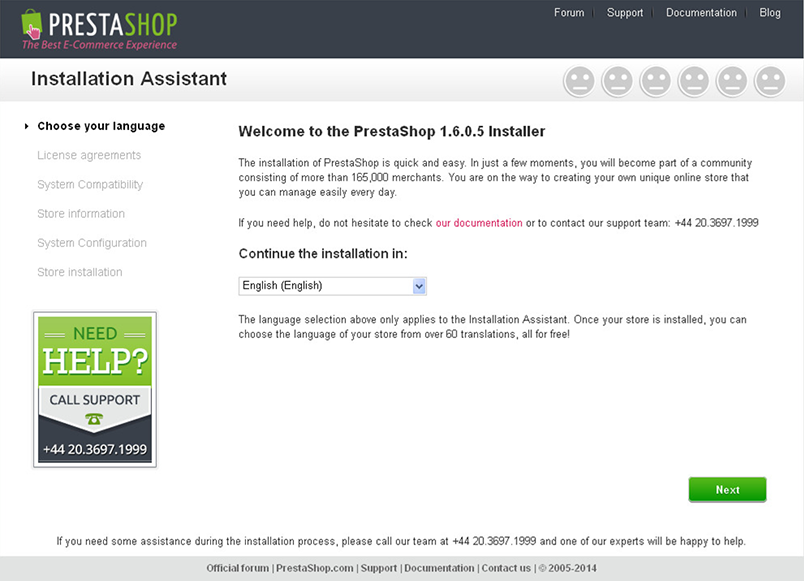
When you are done, click the 'Next' button.
Step 2: Installation Assistant (License agreements)
Please check the license agreement.
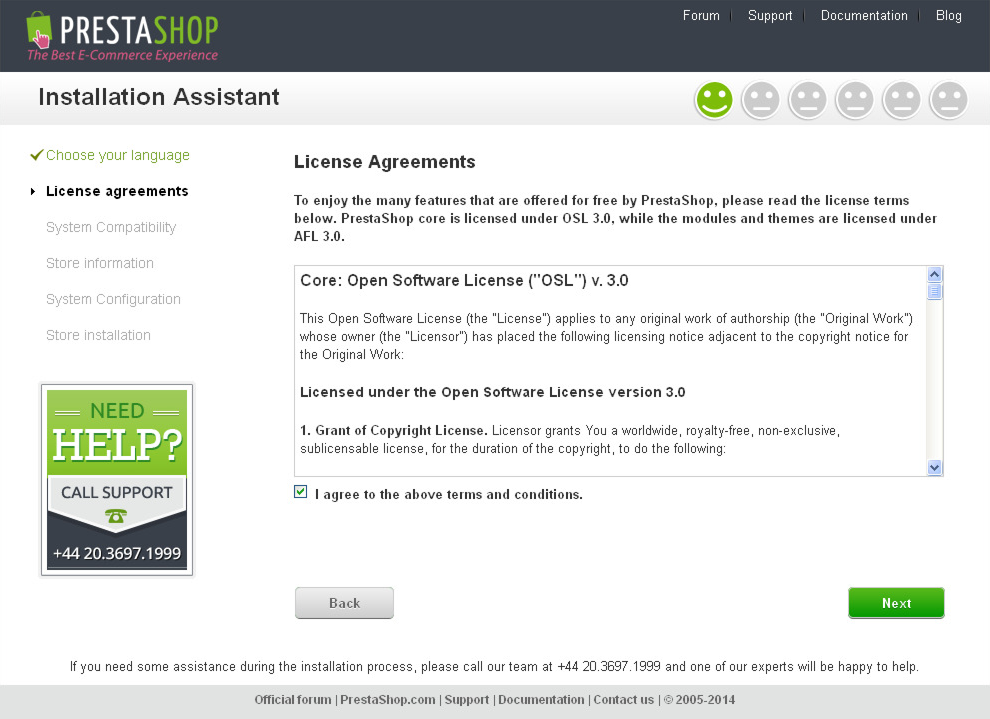
When you are done, click the 'Next' button.
Step 3: System Compatibility
Check the PHP settings and directory permissions. In case of any errors, please contact your hosting provider for further assistance.
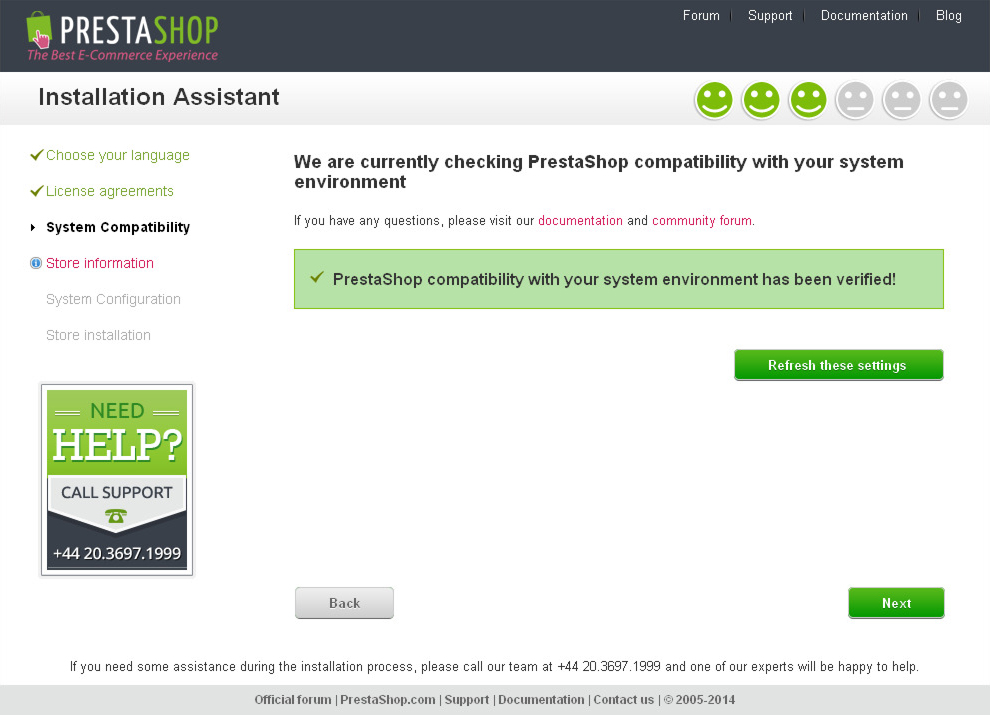
If everything is correct, click the 'Next' button.
Step 4: Shop configuration
This step requires you to enter the store settings like Shop name, activity, country, timezone, etc.
All these settings can be changed later in your PrestaShop administration panel.
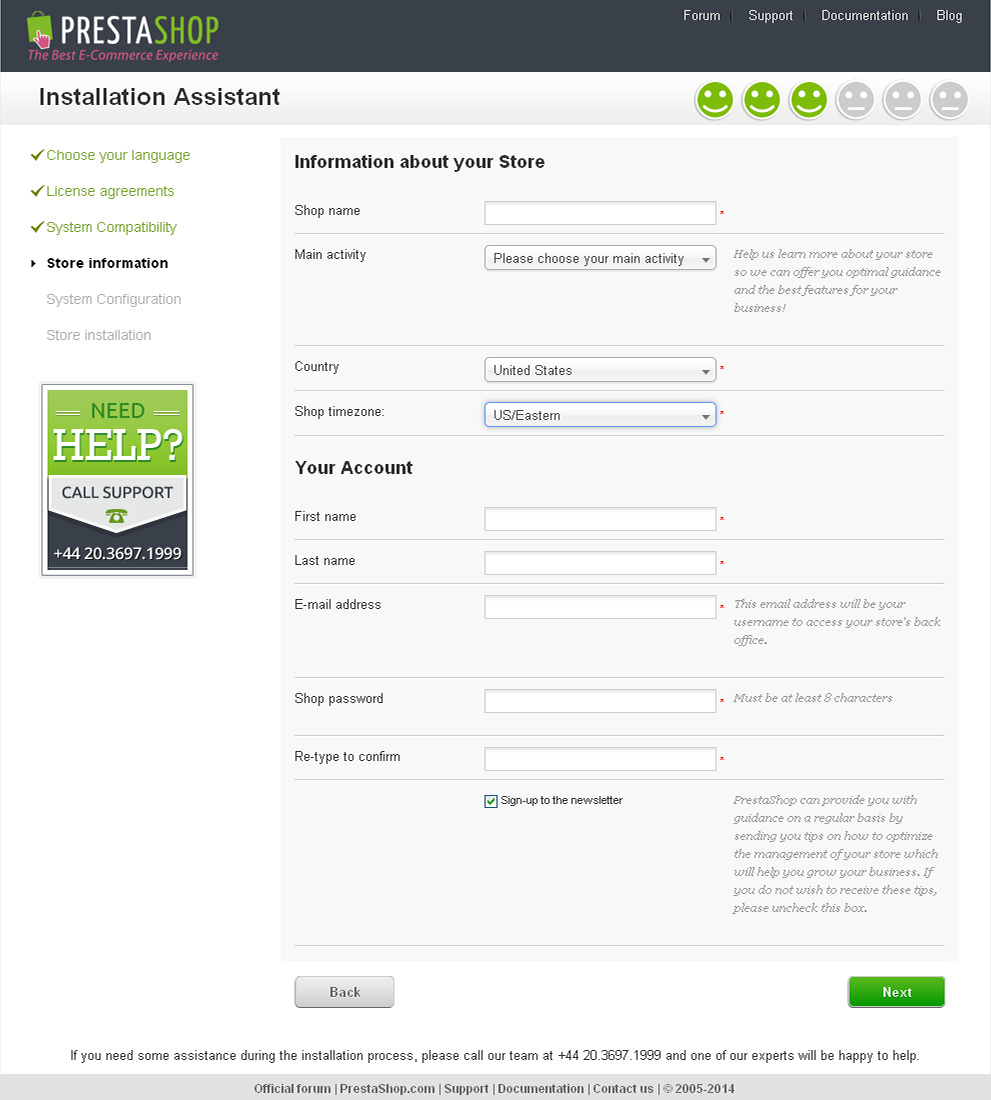
Step 5: System Configuration
if you already have a MySQL database, please enter the database details into the appropriate fields below.
Otherwise, you can get the database details from your hosting control panel or by contacting hosting provider.
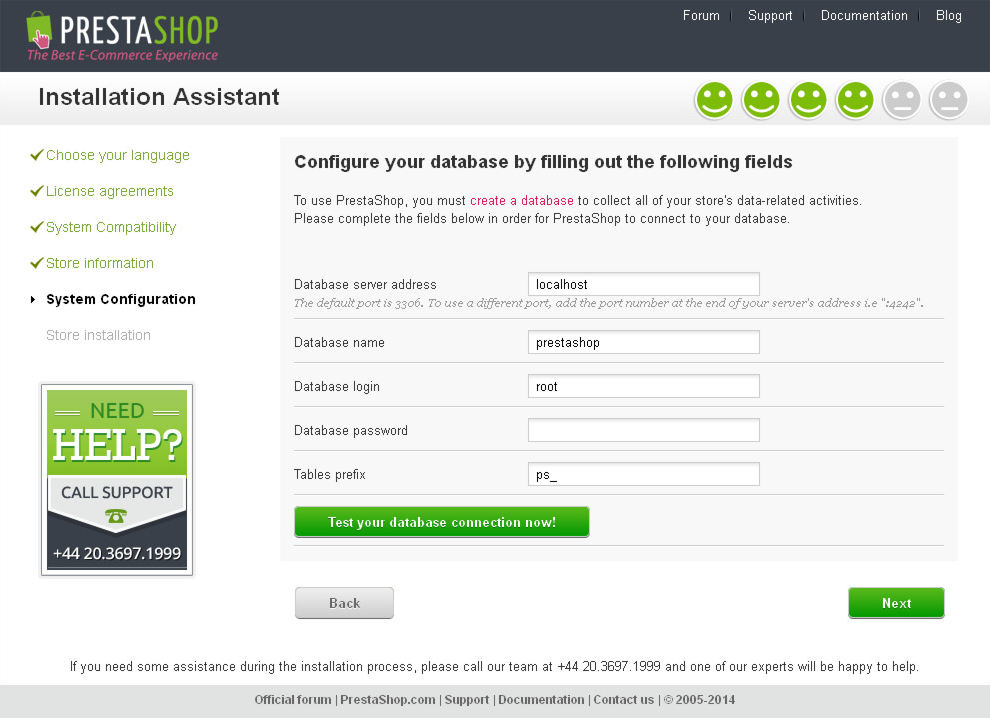
When you are done, click the 'Next' button.
Step 6: Installation is complete
This is the final step of the installation.

For security reasons you need to delete the /install/ directory on your hosting server.
Starting with version 1.5.4, PrestaShop takes care of renaming the administration folder for you: it becomes the word "admin" followed by 4 random digits, i.e. "admin8814." The renaming happens as soon as you reach the "admin" folder for the first time: PrestaShop renames it, then correctly accesses the renamed folder.
Log in to the PrestaShop back office by going to your newly renamed "admin" folder, and start filling your catalog with your data.
Log in to the PrestaShop back office by going to your newly renamed "admin" folder, and start filling your catalog with your data.
If you face any difficulties, please check the official PrestaShop installation manual.
PrestaShop Template installation
If you don't want to spend your time installing the template, don't hesitate to order installation service using our live-chat.
1. Import theme
Note: this method does not provide sample data installation.
1. Template preparation.
Before you proceed, please make sure you have already downloaded the template and extracted the files from the template package. You can check detailed tutorials on how to extract files from the template package using WinZip and StuffitExpander.
When the files are extracted, you can proceed to uploading the template.
2. Installation.
Login to your Prestashop admin panel and navigate to Preferences -> Themes. At the top of the page click the Add new theme button.

Click the Add file button in Import from your computer section. Navigate to previously unzipped template package and open themeinstallator folder:
Select your theme .zip file and click Save
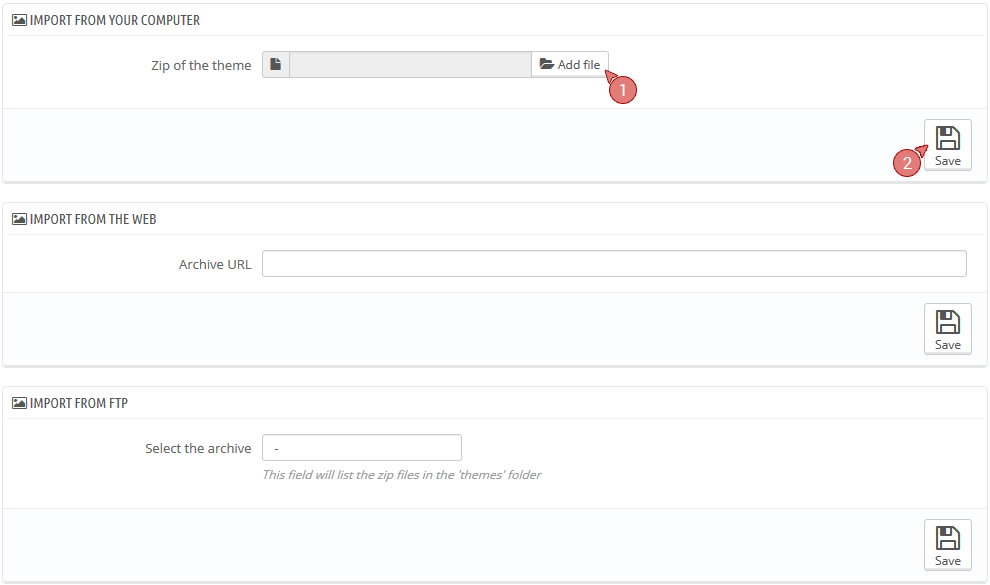
The uploading process will be started. You will see the message that the theme has been successfully uploaded. Your new theme preview will appear in the list of installed themes.
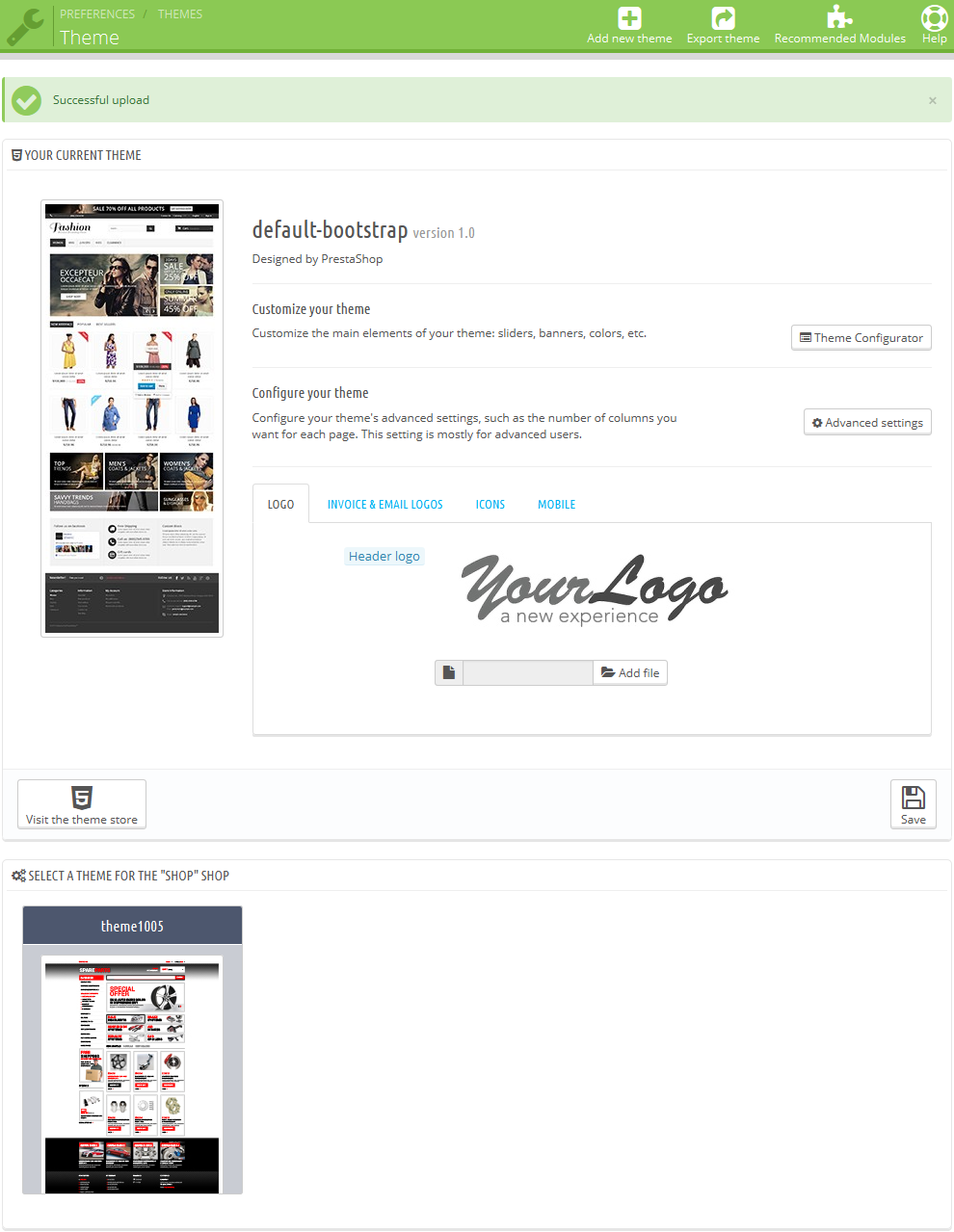
In order to activate the theme, rollover cursor at the theme preview icon and click Use this theme.
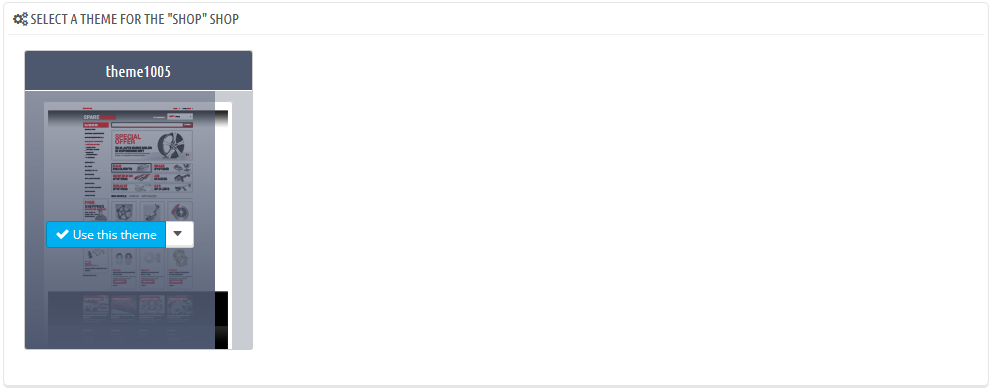
You should see the screen with the information of the modules used in the theme, the number of modules that are turned on and off. Click Save in order to continue.
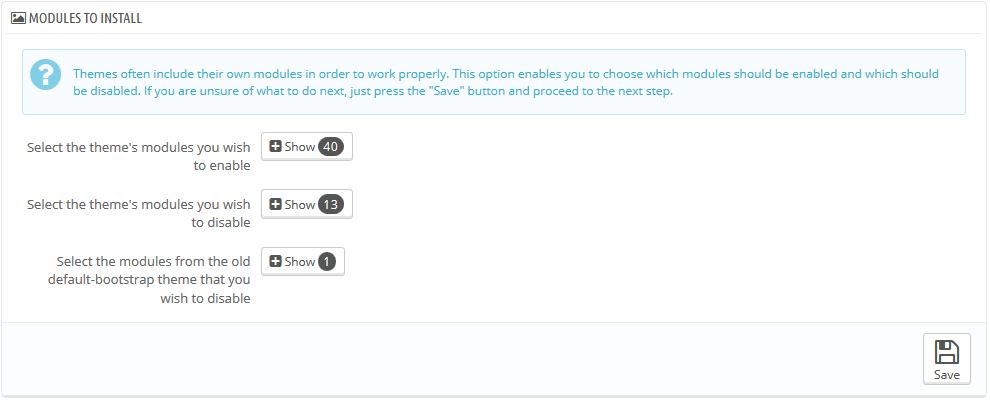
After this you will see the pop-up with the message about successful theme activation: the theme has been installed successfully, images have been re-generated up to the defined in theme dimensions. To finish installation click Finish button.
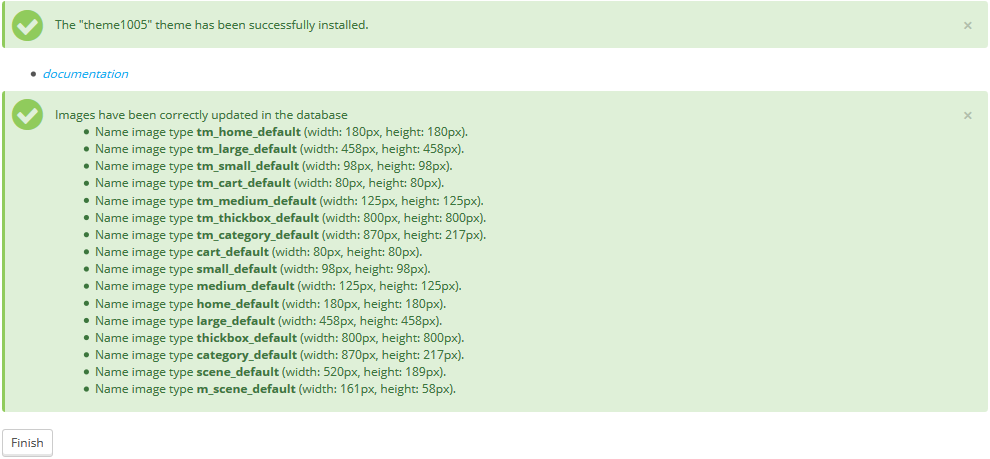
2. Automatic installation with demo data (Sample data installer)
If you don't want to spend your time installing the template, don't hesitate to order installation service using our live-chat.
After installing sample data, you'll get your Prestashop store appear same as at the template live demo. It will contain all demo products, categories, modules and store settings.
Please, do not use the sample data for your running website! This will replace all your store products and store settings.
In order to install sample data using the Sample data installer module please follow instruction from the step 1 (Theme import) of this manual. Then in your store admin panel you'll see Sample data installer module.
Using this module you can easily install store sample data in few easy steps. Please do the following:
- From the admin panel menu click "Install Demo Store" item.
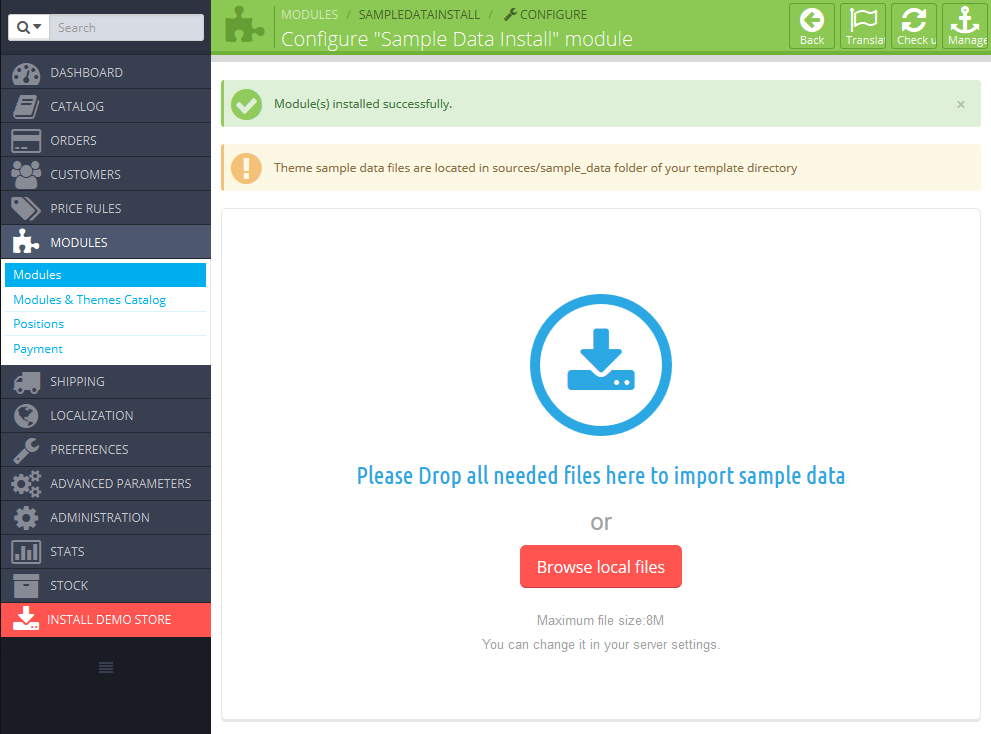
- Select and upload sample data files from 'sample_data'
directory of your template package. You can do this using the "Browse local
files" button or dragging sample data files to the browser window.
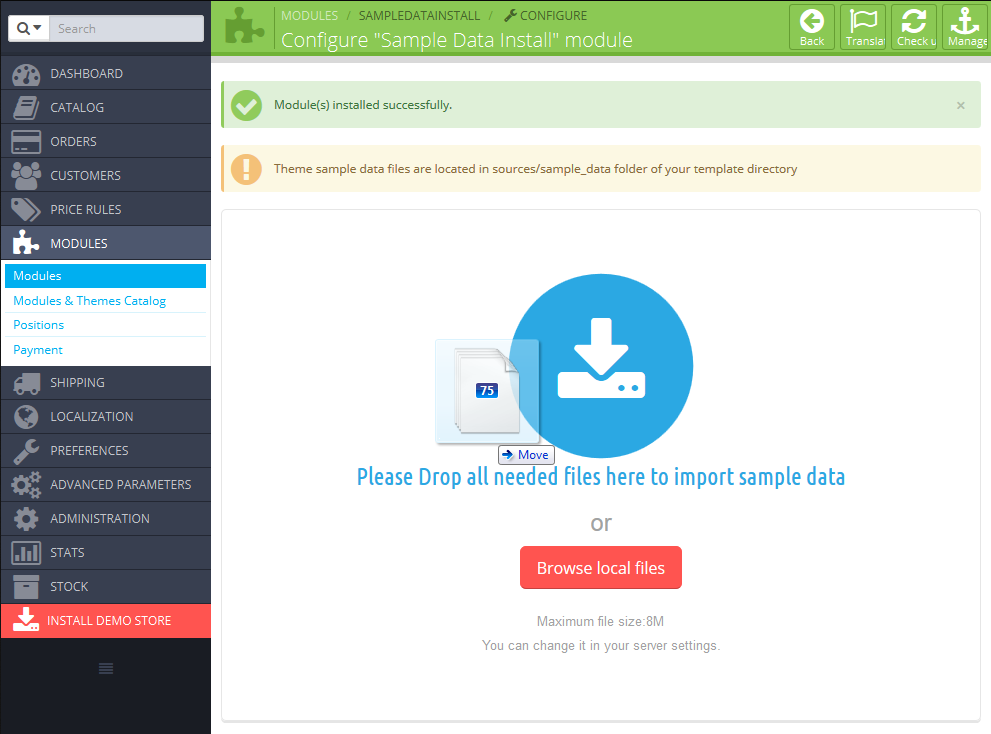
- Wait till files are uploaded:
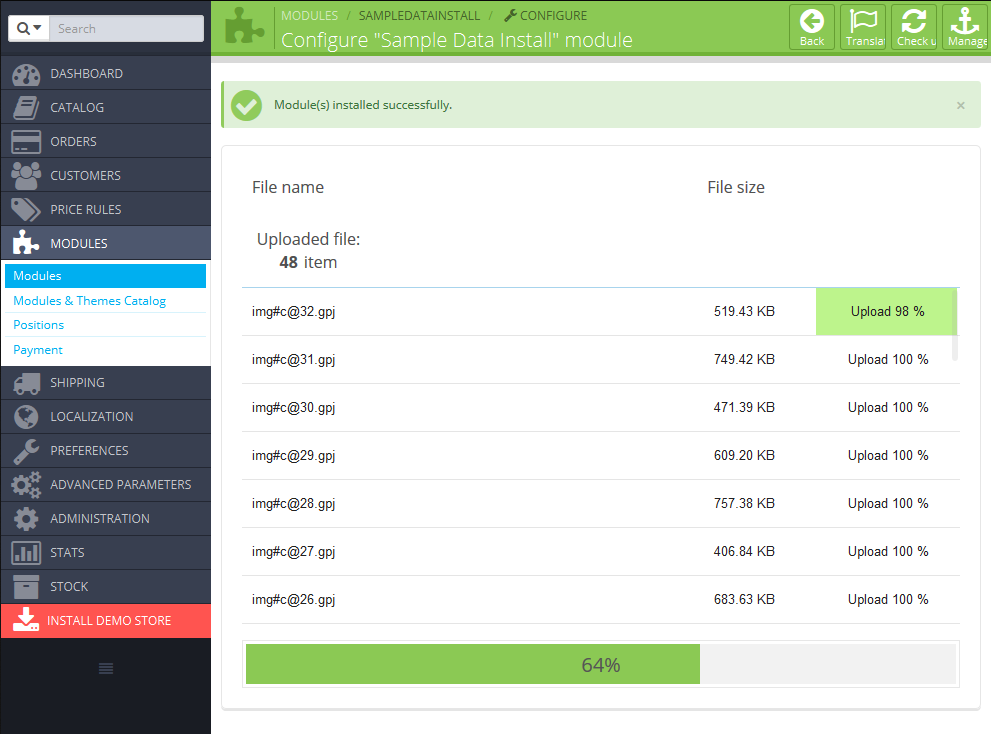
- Then click "Continue Install" button:

- Then Sample data installer will automatically configure your store and other
modules. This can take several minutes.
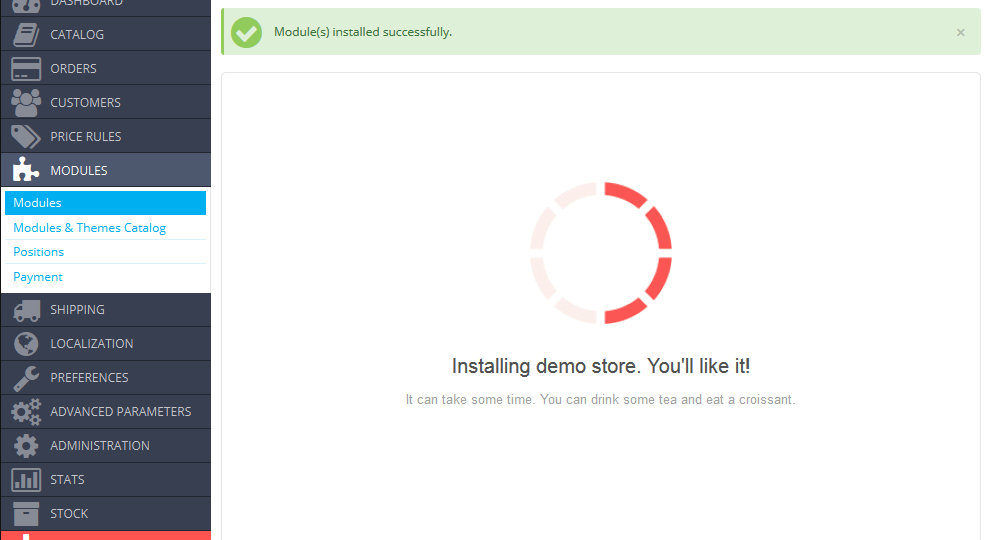
- When sample data is installed successfully you need to perform last step -
regenerate images. Click "Go To Regenerate Page" button.
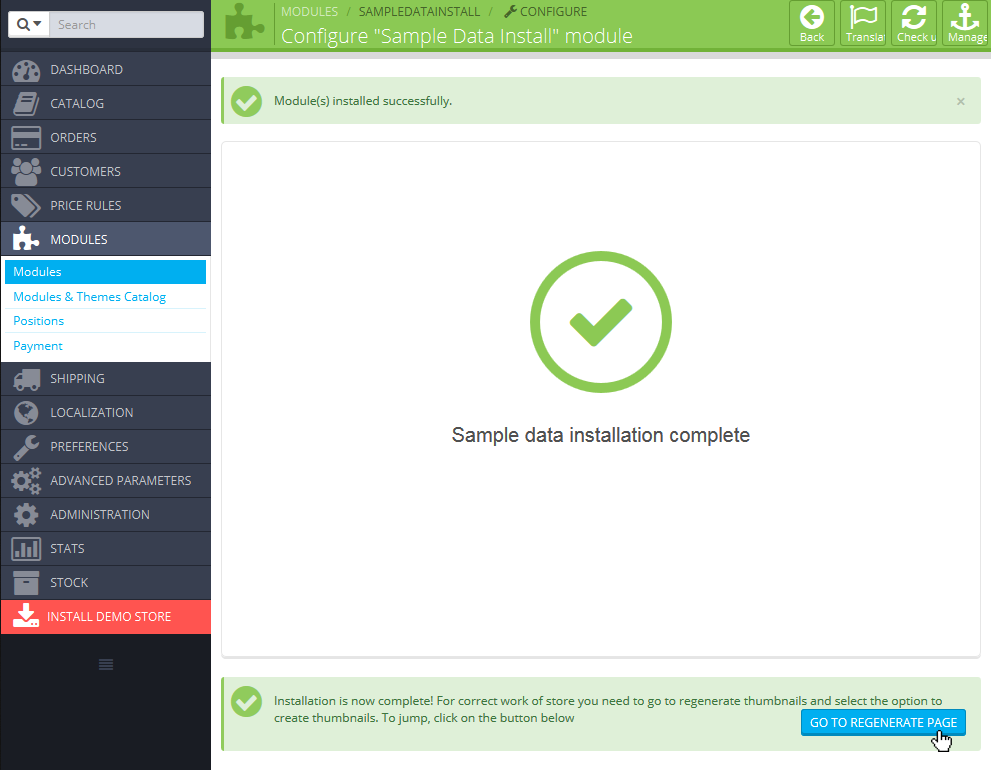
- To regenerate images click "Regenerate thumbnails" button
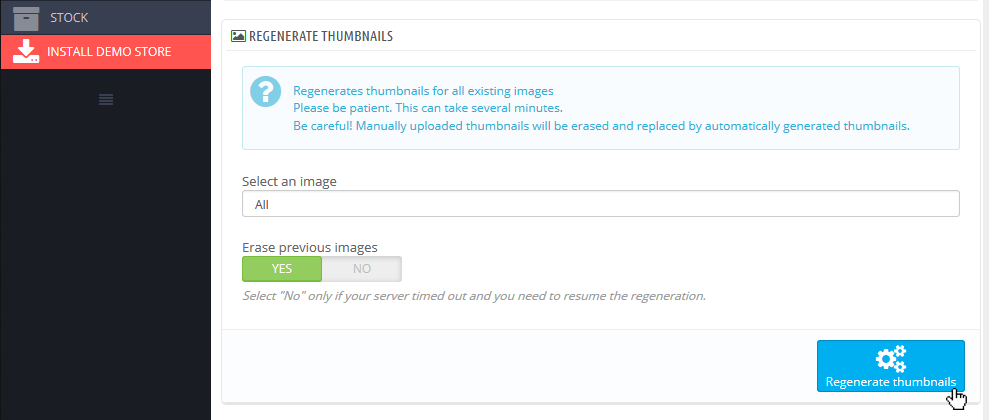
3. Manual template installation with sample data
If you don't want to spend your time installing the template, don't hesitate to order installation service using our live-chat.
After installing the Sample data, you'll get your PrestaShop store to look like the template preview page. It will contain all sample products, store settings, modules settings, etc.
Please, do not use the sample data for your running website! This will replace all your store products and store settings.
1. Uploading template files
To upload the template to your server:
- Open the template package.
- Then go to the /theme/ folder.
- Upload /img/, /modules/ and /themes/ folders to PrestaShop root directory.
You can check the detailed video tutorial on how to upload files to server using FTP manager and how to upload files to a server using cPanel (WebHost Manager, WHM).
2. Installing Sample data
Sample data is provided as an .SQL file. It is located in the root of the template package and is called dump.sql.
The dump.sql file can be installed using the phpMyAdmin tool or some other database management tool in your hosting control panel. This detailed tutorial on how to install SQL files can help you.
Before you proceed, please back up your database. You can check the detailed video tutorial on how to back up a database.
Please, make sure your version of PrestaShop engine matches the template requirements. Otherwise, the database will be damaged.
When you are done with installing the dump.sql file, you will need to activate the template.
From the PrestaShop admin panel, go to Preferences > Themes, choose your template in the Themes section and click Save.
3. Adding languages to online store.
After the multi-language template has been installed, you will be able to add all languages provided with it (English, French, Spanish, German, Russian) to the online store platform. It can be done this way:
Go to 'Localization > Translations' in the admin panel, find 'Translation exchange' and add languages by choosing them from the drop-down menu and clicking the 'Add or update a language' button.
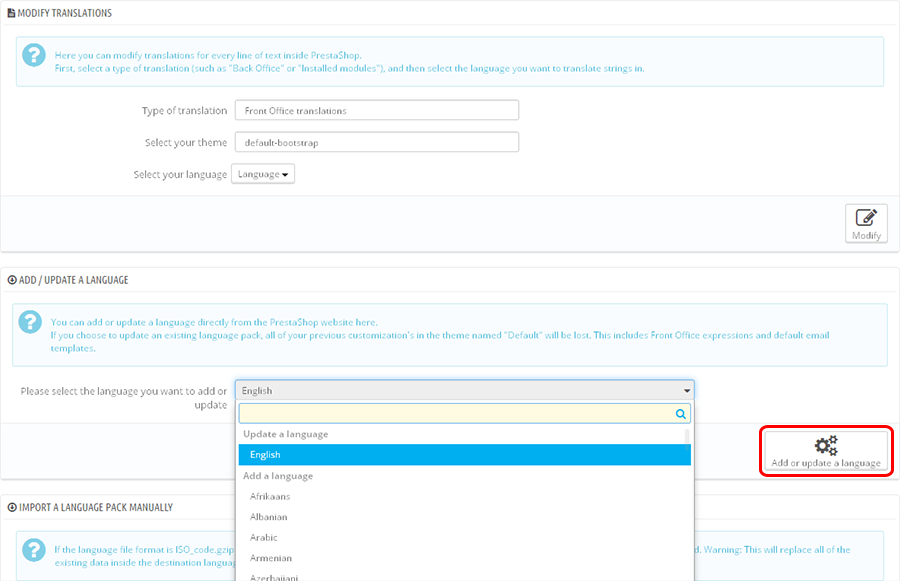
If you do not want to add some languages, you can delete them or turn them off in the 'Localization > Languages' menu.

4. Installing template over existing store
You can use this method of installation if you have a running PrestaShop website and just want to install a new template.
1. Uploading template files and theme activation
- Open the template package.
- Then go to the /theme/ folder.
- Upload /modules/ and /themes/ folders to PrestaShop root directory.
- Open the /img/ folder from the template package and upload the logo.jpg and favicon.ico files to the /img/ folder of your PrestaShop installation.
- From the PrestaShop admin panel go to Preferences > Themes, choose your template in the Themes section and click Save.
You can check the detailed video tutorial on how to upload files to server using FTP manager and how to upload files to a server using cPanel (WebHost Manager, WHM).
2. Modules installation
Open the PrestaShop admin panel and configure modules as described in the Installing template without sample data ->Installing and configuring modules section of this manual.
Do not use sample data if you have a running website as it will replace all your store products and store settings.
3. Configuring images
Open your PrestaShop admin panel and configure the images as described in the Installing template without sample data ->Configuring images section of this manual.
Basic tutorials
1. How to change store name
In order to change your store title, open the PrestaShop admin panel and go to Preferences > Store Contacts, the Contact details section.
In the Shop name field, type in your store name and click the Save button to save your changes.
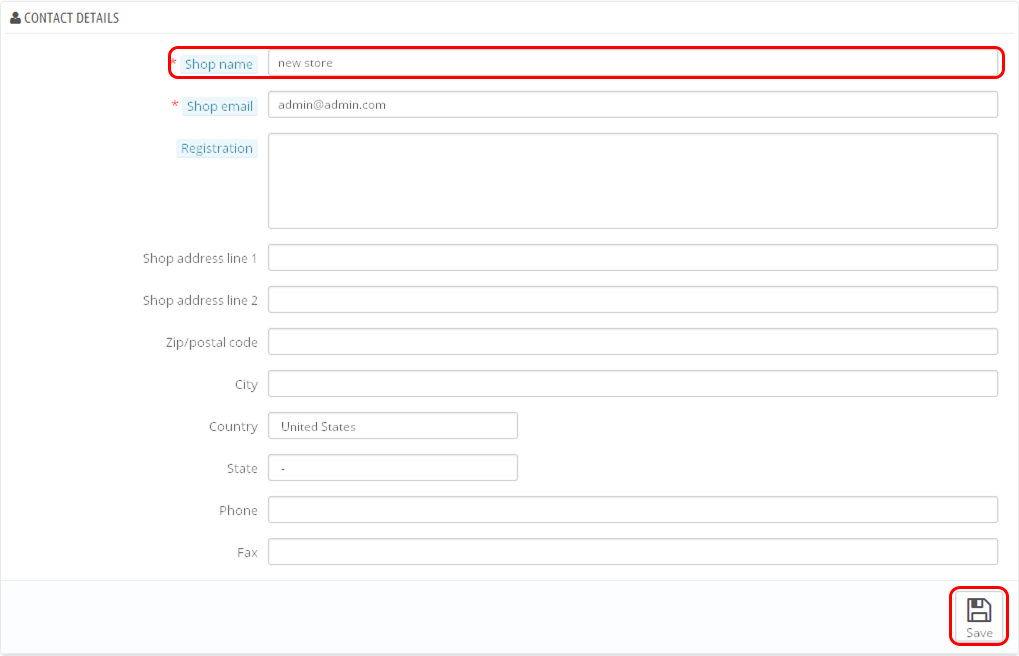
2. How to edit slider
To edit slider images, find the Image slider for your homepage module on the Modules page of your PrestaShop store. It is located in the Front Office Features modules section. Click the Configure button to edit the module.

On the module settings page you can change the slider options (such as width, speed, etc.) and edit slides (slide images, URLs, descriptions, etc.).
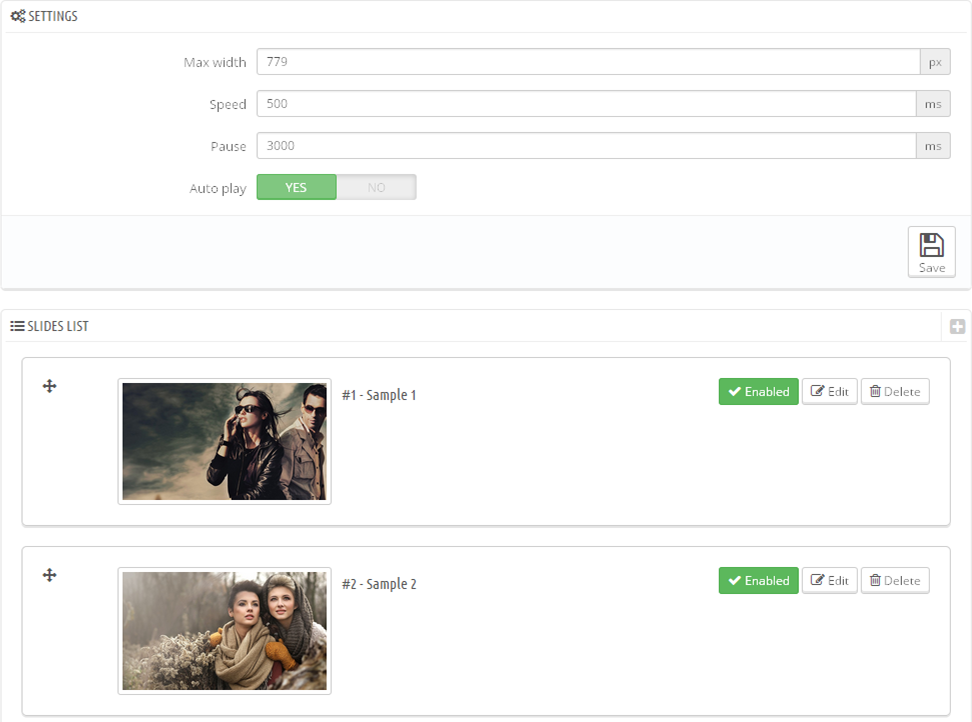
Extensions configuration
Olark Live Chat
To set up a live chat like the one on the Live Demo, you will need to register on the official Web site Olark registration. After you provide all the data required, you will get a code to add to \themes\themeXXX\footer.tpl before </body> tag.
Cookies Policy
Following the Cookie Law conditions, you should add appropriate modules to your website that will display a warning message about the cookies used on your website. We can recommend the following ones:
 Documentation
Documentation